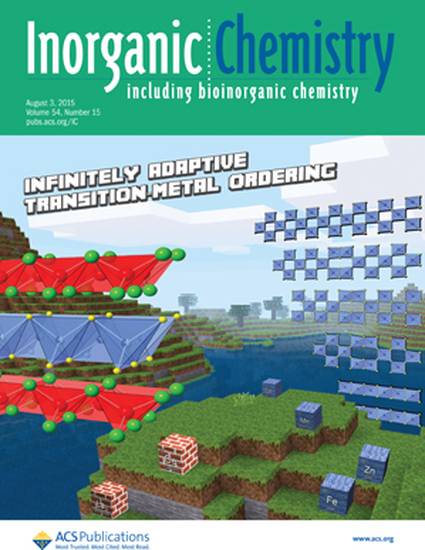
Article
Probing the Protonation State and the Redox-Active Sites of Pendant Base Iron(II) and Zinc(II) Pyridinediimine Complexes
Inorganic Chemistry
(2015)
Abstract
Utilizing the pyridinediimine ligand [(2,6-iPrC6H3)N═CMe)(N(iPr)2C2H4)N═CMe)C5H3N] (didpa), the zinc(II) and iron(II) complexes Zn(didpa)Cl2 (1), Fe(didpa)Cl2 (2), [Zn(Hdidpa)Cl2][PF6] (3), [Fe(Hdidpa)Cl2][PF6] (4), Zn(didpa)Br2 (5), and [Zn(Hdidpa)Br2][PF6] (6), Fe(didpa)(CO)2 (7), and [Fe(Hdidpa)(CO)2][PF6] (8) were synthesized and characterized. These complexes allowed for the study of the secondary coordination sphere pendant base and the redox-activity of the didpa ligand scaffold. The protonated didpa ligand is capable of forming metal halogen hydrogen bonds (MHHBs) in complexes 3, 4, and 6. The solution behavior of the MHHBs was probed via pKa measurements and 1H NMR titrations of 3 and 6 with solvents of varying H-bond accepting strength. The H-bond strength in 3 and 6 was calculated in silico to be 5.9 and 4.9 kcal/mol, respectively. The relationship between the protonation state and the ligand-based redox activity was probed utilizing 7 and 8, where the reduction potential of the didpa scaffold was found to shift by 105 mV upon protonation of the reduced ligand in Fe(didpa)(CO)2.
Keywords
- Protonation state,
- Ligand-based redox-activity
Disciplines
Publication Date
August 3, 2015
DOI
10.1021/acs.inorgchem.5b00633
Publisher Statement
Copyright 2019 American Chemical Society
Citation Information
Probing the Protonation State and the Redox-Active Sites of Pendant Base Iron(II) and Zinc(II) Pyridinediimine Complexes. Mayra Delgado, Samantha K. Sommer, Seth P. Swanson, Robert F. Berger, Takele Seda, Lev N. Zakharov, and John D. Gilbertson. Inorganic Chemistry 2015 54 (15), 7239-7248
DOI: 10.1021/acs.inorgchem.5b00633
